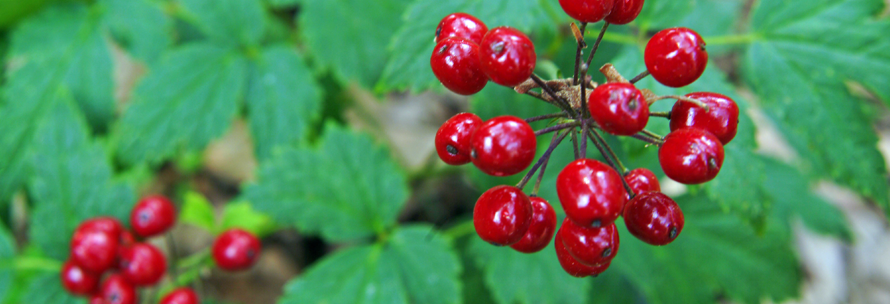Would You Be Able to Identify Poisonous Plants?

Even if you’re a keen gardener, you might not be aware of exactly which species of plants can actually be harmful or poisonous to humans. These plants are an important part of our ecosystem and many are a food source for insects and birds. They contain substances they need for their own survival which sometimes interacts with the substances either we or an animal need for survival and this can cause harm.
How are birds able to eat poisonous berries?
The simple answer is that the berries aren’t poisonous to them. They most likely don’t have any substances in their body which will combine with the poison and cause a reaction.
How many people died from being poisoned by plants?
Very few people die from accidentally ingesting poisonous parts of plants. The reason for this is that most poisons will induce vomiting, which often removes enough of the poison from the stomach before it has a chance to do any real harm.
Often poisonous plants will not look nice enough to eat. Detering people from doing so, and they often have an extremely bitter and unpleasant taste.
The total deaths from the ingestion of poisonous plants in Europe are so low that they don’t collect figures. The British Medical Journal published figures going back to the years from 1958 to 1977 on accidental deaths from poisoning in children under 10. Only 1 death was confirmed as being caused by a plant. The report stated that there were many more deaths from the ingestion of medications and household cleaning products than plants.
Where are poisonous plants most often found?
You might find some of them in your garden, but you will most often find harmful plants in the wild or on public land, like in parks.
5 of the most common poisonous plants
Poison hemlock (Conium maculatum)
Hemlock is a large plant, which can grow up to 2m tall. It has a hollow stem, with purple blotches on it. The plants have an unpleasant smell, which people often describe them as being like rodent urine. Hemlock is located in damp areas on the edge of woodland, near streams and ditches.
The poisonous compounds from this plant are poisonous to humans and livestock, and consuming even a small amount can paralyse the respiratory system and cause death.
Foxglove (Digitalis purpurea)
This tall plant has tube-shaped pink and purple flowers, which grow on a spike. It’s usually located along the edges of woodland, along hedgerows and in gardens.
Foxglove contains toxic compounds called cardiac glycosides, which if ingested can cause severe poisoning and symptoms like nausea, headaches, skin irritation and diarrhoea. In particularly bad cases, it can cause visual disturbances, and heart and kidney problems.
The plant is very valuable to bees, so if you have it in your garden, you don’t have to get rid of it, just be careful.
Lords and ladies (Arum maculatum)
This poisonous plant is located in woodland and along the edge of hedgerows. It has large, arrow-shaped leaves with purple spots and berries that can be green, orange or red.
The berries are very poisonous. They contain compounds called saponins which have needle-shaped crystals that cause irritation to the skin, mouth, tongue, and throat. This causes swelling of throat, difficulty breathing, a burning pain, and an upset stomach. Luckily, however, the bitter taste and initial tingling sensation tend to be off-putting to anyone who might want to eat the berries and this will usually prevent them from eating too much. Take care when handling this plant, as all parts of the plant can cause allergic reactions.
Deadly nightshade (Atropa belladonna)
You can tell this is bad, just by the name! The flower of the plant is bell-shaped and a purple-green colour. The leaves are oval-shaped and the berries are green, but turn to black when they are ripe. You will most likely find it in the south of the UK in woodland, and along paths.
All parts of the plant are toxic, but the berries are very poisonous. They contain a mixture of compounds called tropane alkaloids that can interfere with the nervous system. The compound atropine which is found in the plant causes symptoms like sweating, vomiting, breathing difficulties, confusion, hallucinations and even coma and death.
Monkshood (Aconitum napellus)
Monkshood has attractive blue, purple, white, yellow, or pink flowers that grow on a tall spike. It’s mostly located in the south of the UK in damp woodlands, in meadows and along ditches. It usually flowers from June to September.
The entire plant is poisonous, especially the roots. The poisons in the plant can get into the skin via cuts and abrasions, so always wear gloves when you’re in the garden. If you consume the plant, it can cause a stomach upset and dizziness. In large amounts, it can affect the heart, but because the plant tastes so unpleasant, it is unlikely that someone would ingest enough of it to cause this effect.
Advice if you suspect ingesting poisonous plants
If you think a child or adult has eaten part of a potentially poisonous plant, seek medical advice immediately. Attend hospital, and take a sample of the plant with you. Include as many parts of the plant as you can for easier identification. Don’t make the person sick.
If a pet has ingested a poisonous plant, attend the vet’s surgery, and take a sample of the plant with you. Have we peeked you interest in even more helpful tips and interesting articles. Check out our blog.








